![]() 1st Battalion 22nd Infantry
1st Battalion 22nd Infantry ![]()
The 22nd Infantry 1879-1889
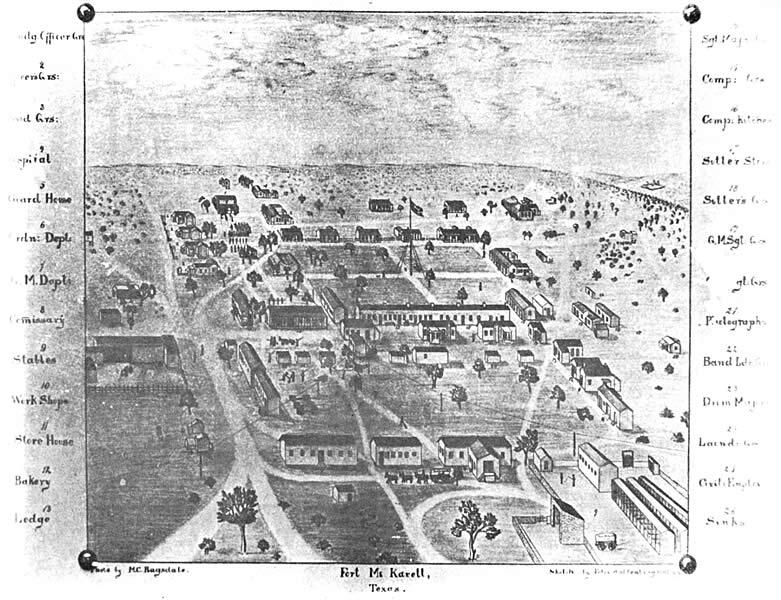
Bird's-eye view of Fort
McKavett, drawn in 1878 after a substantial program of rebuilding
and construction.
The 22nd Infantry had several Companies stationed here during the
years 1879-1882.
Illustration from the website Texas Beyond History
The following narrative is taken
from the Regimental History compiled in 1922.
Passages in brackets are from the Regimental History written in
1904.
CAMPAIGNS AGAINST THE UTE, APACHE, AND NAVAJO INDIANS
In April, 1879, while the 22nd Infantry was in
the act of complying with orders to proceed to the Department of
Texas,
Companies D, E, F, and K were detached and sent to Fort Gibson [
under command of Colonel Hough ] , Indian Territory;
this move being made on account of slight difficulty with the
Indians in that locality. In the Department of Texas Companies B,
C, H, and I
took station at Fort McKavett; Company A at Fort Griffin. [ Fort
McKavett was made sad and gloomy, July 4, by the death
of Captain T. H. Fisher, a very popular officer in the regiment.
] A few weeks later Company E settled down at Fort Vinita, Indian
Territory,
while Company K went to Coffeeville, Kansas; these two companies
being charged with the duty of keeping undesirable land grafters
and others out of Oklahoma. [ .......for the purpose of keeping
boomers out of Oklahoma and of protecting the inhabitants
from the robbers who infested that part of the country. ]
In the latter part of 1879 signs of war with
the Ute Indians in Colorado began to appear. As a result of this
danger
the companies of the 22nd Infantry at Fort Gibson were sent under
Colonel Hough to Alamosa, Colorado, by train;
thence by marching to Animos, where they joined detachments of
the 15th Infantry and the 9th Cavalry and became part
of the command of Colonel G. P. Buell. The mission of this force
was to prevent a junction of the Northern and Southern Ute
Indians.
In January, 1880, the detachment of the 22nd
Infantry returned to Gibson by way of Santa Fe, New Mexico.
[ In January, 1880, the companies of the 22nd were ordered back
to Gibson, and on account of deep snow in the mountains,
they were compelled to march to Santa Fe, New Mexico, where they
met with a grand ovation. From that place
they went by rail to Gibson, having marched over five hundred
miles. ] From Gibson Company E proceeded
to San Antonio, Texas, for station; Companies D and K marched
over a hundred miles to Fort Clark,
where they joined Regimental Headquarters and Company H.
The regiment remained in Texas until it was
ordered to the Department of the Missouri in November, 1882.
Headquarters of the regiment then took station with Company E at
Santa Fe, New Mexico;
Company A went to Fort Garland; B, G, H, and K to Fort Lewis; C,
D, F, and I to Fort Lyon, the latter posts all in Colorado.
|
A Corporal of Company D 22nd Infantry Photo taken at Fort Lewis,
Colorado |
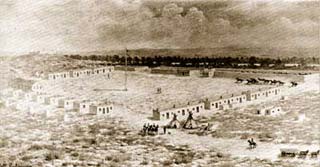
Fort Lyon, Colorado

Fort Lewis, Colorado 1880's
From a photo taken by Christian Barthelmess ( Photographer & Musician - 22nd Infantry ) , from the book:
Photographer On An Army Mule
by Maurice Frink, University of
Oklahoma Press
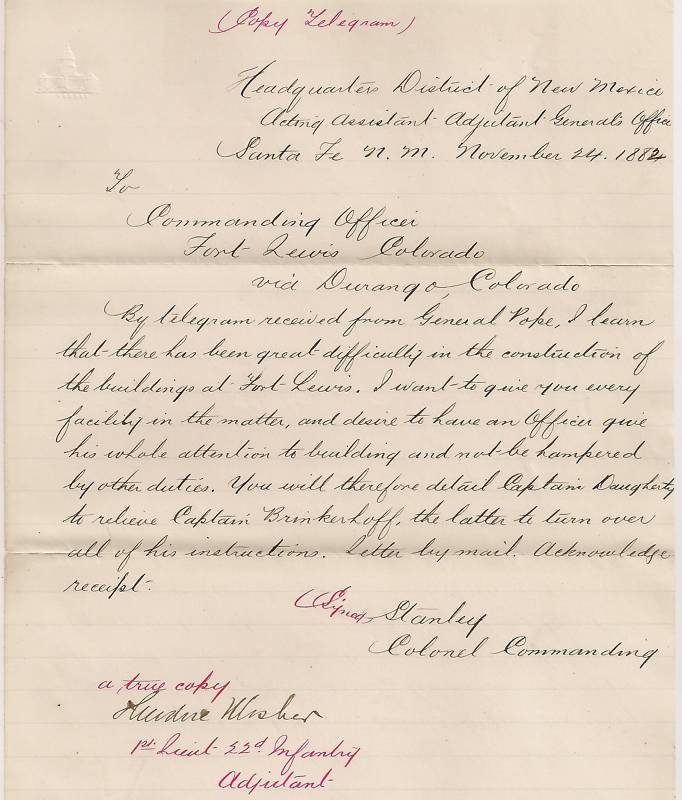
A "true copy" of a telegram
sent by the Commanding Officer of the 22nd Infantry,
David S. Stanley, to the commanding officer at Fort Lewis,
Colorado, November 24, 1882.
The 22nd Infantry had just been ordered to occupy Fort Lewis, and
apparently the buildings
were not ready to be moved into. The construction of the Fort was
begun by the 13th Infantry
in 1880, and as of the date of this letter construction was not
finished. Apparently the 15th Infantry
had taken over construction, as this letter directs that Captain
William Daugherty of the 22nd Infantry
be directed to take over construction from Captain Henry
Brinkerhoff of the 15th Infantry.
The letter was written and signed by 1st Lieutenant Theodore
Mosher of the 22nd Infantry,
in his capacity as acting Adjutant.
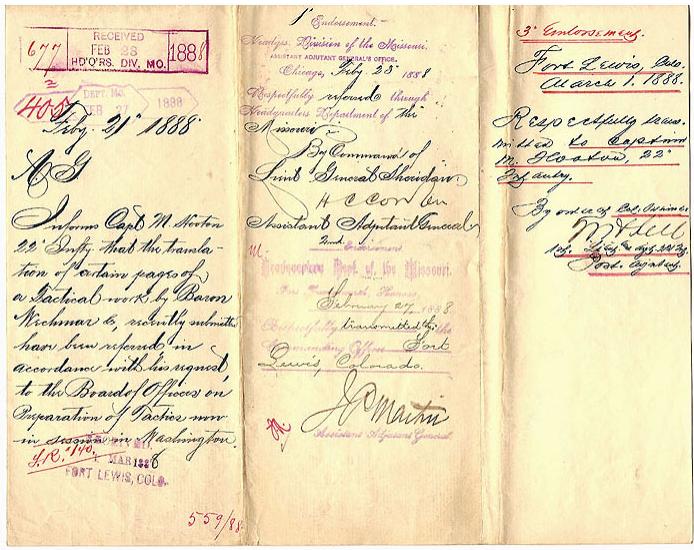
Communication to Fort Lewis, Colorado,
received and endorsed by 1st Lieutenant W.H. Kell, Adjutant 22nd
Infantry,
on March 1, 1888, informing Captain M. Hooton that a translation
he had previously sent to the Adjutant General's Office
in Washington, D.C. had been received and forwarded to the
appropriate Army authority for review.
The translation was of certain pages of a tactical work by Baron
Wechmar, a General in the German Army and written in 1875.
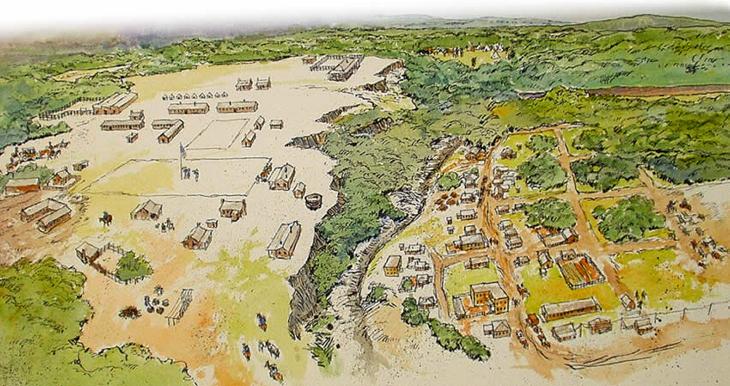
Fort Griffin, Texas
Illustration from the website: Texas Beyond History
In September, 1885, trouble with marauding
Apache Indians caused Company E to be sent from Santa Fe to Datil
Creek,
where it was engaged in maintaining the supply channels for
troops operating against the Apaches in the Mogallones.
Company E returned to Santa Fe on April 26, 1886. From this time
until November of the same year the entire regiment
was camped at the mouth of the Rio De La Plata, on the lookout
for disturbances among the Ute and Navajo Indians.
Company E, during this period, was detailed as guard over the
White Spring Apache Indians on their way to St. Augustine,
Florida,
where they were being sent for a period of restraint on the
Military Reservation. The Company returned to Santa Fe September
30, 1886.
Several months' quiet was now enjoyed by the
entire regiment, but in July, 1887, further trouble from the
Indians being expected,
two camps of one company each were established; one near North
Montezuma, 110 miles from Fort Lewis;
the other near Mcelmo, both in Utah. The former camp was
continued until September 5th, and the latter until October 14th,
on which dates the camps were discontinued and the companies
returned to Fort Lewis.
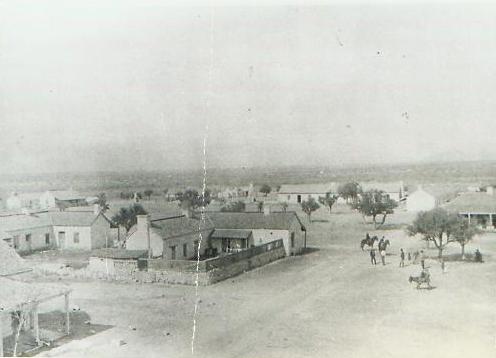
Fort McKavett, Texas

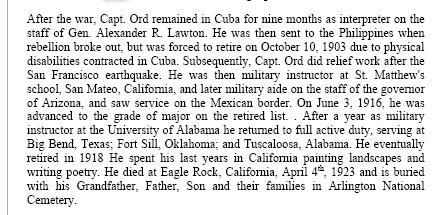
Article from the Fort McKavett Gazette, Volume 4, Number 1, January 2005, taken from:
The Friends of Fort McKavett State Historic Site
Henry Clay Hodges Jr.
Henry Clay Hodges Jr. Seen here in a formal portrait
taken shortly after his |
--------------------- |
Henry Clay Hodges Jr. Seen here as a Brigadier
General, United States Army, |
Henry Clay Hodges Jr. was born April 20, 1860. His father was an officer in the US Army from 1851 to1895.
He was appointed to West Point by Ulsysses S.
Grant in 1877 and obtained his commission as a Second Lieutenant
of the 22nd Infantry in 1881.
His first 20 years of service were with the 22nd Infantry
Regiment, including time in the Philippines during the
Insurrection and Moro Wars.
After four years of recruiting duty and Construction
Quartermaster, Hodges returned to the 22nd Infantry Regiment as
Commander
of the 2nd Battalion from 1905-06. Following more time in the
Philippines and attending the Army War College, Hodges rejoined
the 22nd Infantry Regiment again, this time in Fort Seward,
Alaska, from 1909-10, and at Fort Sam Houston, Texas, from
1910-11.
From 1911-14, Hodges served the Office of the Army Chief of Staff
and General Staff, before returning to Texas to command
the 17th Infantry Regiment from 1914-16. From there he took
command of the 1st Infantry Regiment in Hawaii before leading the
39th Division
as Commanding General for the American Expeditionary Force in
World War I from 1917-18.
After the war, General Hodges took command of the 17th Division
at Camp Beauregard, Louisiana.
Major General Henry Clay Hodges, Jr. commanded the Hawaiian
Department from March-May of 1919.
He concluded his career as Commanding General of Schofield
Barracks from 1919 until his retirement in December of 1920.
He died in 1963 at the age of 103.
Cadet, U S. Military Academy 1877-81 Graduated
as No. 2901, 23rd in the Class of 1881
Appointed Second Lieutenant 22nd Infantry 11 June 1881
First Lieutenant 30 August 1890
Captain 26 April 1898
Major 1905
Lieutenant Colonel 1911
Colonel 1914
Brigadier General 1917
Major General (NA) 1917
Brigadier General 1919
Served with 22nd Infantry Regiment 1881-01 Served in the
Philippines 1899-01
Regimental Adjutant, 22nd Infantry Regiment 29 July 1899 to 8
Sept 1901
Recruiting duty in Boston 1901-03
Construction Quartermaster, Ft´s Rodman, Greble & Adams
1903-05
Commanding Officer, 2nd Battalion, 22nd Infantry Regiment, Ft.
Wayne, Detroit 1905-06
(Ed., the website can't verify this information.)
Commanding Officer, 2nd Battalion, 22nd
Infantry Regiment, Camp Stotsenburg, Philippines 1906
(Ed., the website can't verify this information.)
On Special duty in the Philippines 1906-07
Served with Military Information Division, Headquarters
Philippine Division 1907-08
Student, Army War College 1908-09
Served with 22nd Infantry Regiment at Ft. William H. Seward,
Alaska 1909-10
Court-Martial duty at Seattle 1910
Served with 22nd Infantry Regiment at Ft. Sam Houston 1910-11
Served with the Office of the Army Chief of Staff 1911
Served with the Army General Staff 1911-14 Secretary of the Army
General Staff 1913-14
Commanding Officer, 17th Infantry Regiment at Eagle Pass, Texas
1914-16
Commanding Officer, 1st Infantry Regiment at Hawaii 1916-17
Commanding General, 39th Division, AEF 1917-18
Commanding General, 17th Division & Camp Beauregard (La)
1918-19
Commanding General, Hawaiian Department March-May 1919
Commanding General, Schofield Barracks, Hawaii 1919-20
Retired December 1st, 1920
Died 1963
Buried in Arlington Cemetery
Obituary in Time Magazine July 26, 1963:
Died. Major General Henry Clay Hodges, 103,
West Point's oldest alumnus (class of '81), who was born on the
frontier,
was appointed to the Military Academy by Ulysses S. Grant,
campaigned against Comanches on the Pecos, Moro rebels in the
Philippines,
Pancho Villa in Mexico, and led his 39th Division to France in
World War I, before retiring in 1920 to an old soldier's place of
honor
at every West Point graduation since then except two; in
Stamford, Conn.
Information on H.C. Hodges taken from:
Lieutenant E.W. Casey's expedition to the Grand Canyon
During the months of November and December,
1887, and January, 1888, a military reconnaissance was made from
Fort Lewis
to the Grand Canon of the Colorado River by 1st Lieutenant Edward
W. Casey, with a detachment consisting of
1st Lieutenant Theodore Mosher, 2nd Lieutenant Frank B. Jones,
and 8 enlisted men, all of the 22nd Infantry.
The officers were mounted on their private horses, the enlisted
men on government mules.
1st Lieutenant N. S. Jarvis, assistant Surgeon, U. S. A., and two
civilian packers accompanied the expedition.
The party left Fort Lewis on the 2nd of November, forded the San
Juan River at the mouth of the De La Plata River,
into the Navajo Indian Reservation, crossed the La-ka-chu-kai
Mountains and proceeded by the valley of the Chililee
to Canon de Chelly, up this canon for fifteen miles, thence via
Bonita Canon, reaching Fort Defiance, Arizona, November 16.
From Fort Defiance the route was by Ganado,
Keam's Canon and the Moqui villages of Tewa, Sichomivi, and
Walpi;
thence by the Blue Canon to the small Mormon settlement of Tuba
City. The Little Colorado River was crossed about 30 miles above
its mouth;
thence along the base of the Coconino Mountains, the entrance to
the Grand Canon of the Colorado was reached December 7.
The descent to the river bed, over a faint trail, was effected
the same day.
Five days were spent on the river bank, during which period the
canon was examined to the eastward for ten miles,
as far as the mouth of the Little Colorado. December 13, the
return march was begun.
To Tuba City, the former trail of the expedition was followed;
thence via Red Lake, skirting the Mesa La Vaca,
through Marsh's pass, along the base of the Hay Stack Mountains,
across the Chililee Valley, by Ojo La Casa
through a pass in the Carriso Mountains to the San Juan River,
which was crossed on the ice, at Hyde's Store, December 31.
From Hyde's the wagon road via Ute Mountain, Montezuma Valley,
and the Mancis River was followed, through much snow,
to Fort Lewis, Colorado, where the reconnaissance came to an end
January 5, 1888.
The expedition travelled seven hundred and
forty-seven miles (456 en route to the Canon and 291 on the
return trip),
passing through portions of Colorado, New Mexico, Arizona and
Utah, and crossing the Navajo Indian reservation.
The return to Fort Lewis was accompanied by much hardship from
cold and snow. Two animals fell from the trail into the Grand
Canon
and were lost, while several others succumbed to short rations
and the severity of the weather. [ Two of the enlisted men
sustained injuries. ]
Thermometric and barometric observations were regularly made
throughout the period covered by the reconnaissance,
and the distances travelled were measured daily by means of an
odometer, for which a single wheel, drawn by a mule,
was devised. A mountain transit was also used by Lieut. Jones.
The information gathered by the reconnaissance,
which included lines for heliographic communication, was duly set
forth in the report on, and on the map of, the country traversed,
prepared and submitted by its accomplished commander, Lieut.
Casey.
[ It was understood that much of the country traversed had never
been previously mapped. ]
Ed., The following is from the Regimental History written in 1904:
[ With reference to this expedition, the following letter is of interest:
DEPARTMENT OF THE INTERIOR. UNITED STATES
GEOLOGICAL SURVEY.
WASHINGTON, D. C., February 21st, 1903.
COL. THEODORE MOSHER,
ADJUTANT GENERAL, DISTRICT of COLUMBIA MILITIA, WASHINGTON, D. C.
DEAR COLONEL:—
I recall that you once were on an exploring
expedition along the southern portion of the Grand canon of the
Colorado.
If I am correct, you were in the vicinity of the junction of the
Little Colorado with the main Colorado river.
I would ask, if it is convenient to you, to lay down your routes
at that time on atlas sheets of the geological survey which I
will send you.
I am engaged as opportunity offers in laying down the routes of
explorers on the large map of the United States,
and I believe that you have been in some portions in the vicinity
mentioned where no one had been before.
Therefore, such data as you can furnish me will be of great
interest and value.
I am, very respectfully,
(Signed) GILBERT THOMPSON, Topographer. ]
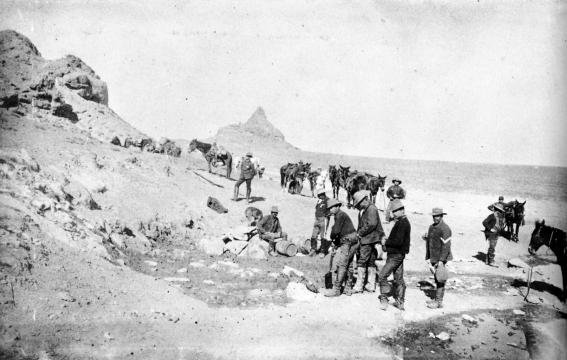
LT Casey's expedition to the Grand
Canyon
Photo taken at Baker's Peak, Arizona. Casey is standing, middle
of the picture, just to the right of the water barrels.
Farther back, looking up the hill is LT Theodore Mosher.
Photo taken by Christian Barthelmess ( Photographer & Musician - 22nd Infantry ) , from the book:
Photographer On An Army Mule
by Maurice Frink, University of
Oklahoma Press
In May, 1888, the regiment changed station to
the Department of Dakota; headquarters, band, Companies A, B, C,
D, F, H and K
going to Fort Keogh, Montana; Companies E and G to Fort Totten,
Dakota; and Company I to Fort Abraham Lincoln, Dakota.
Early in June the different companies had reached their
respective stations and began a period of service in the
northwest which lasted for seven years.
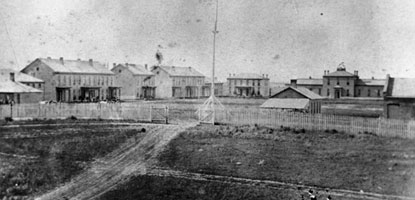
Fort Totten, Dakota Territory
|
Stump Horn, one of Lt. E.W.
Casey's Cheyenne Scouts. From a photo by Christian Barthelmess, From the book: Photographer On An Army
Mule Also in the National Archives as: NARA_-_523855 |
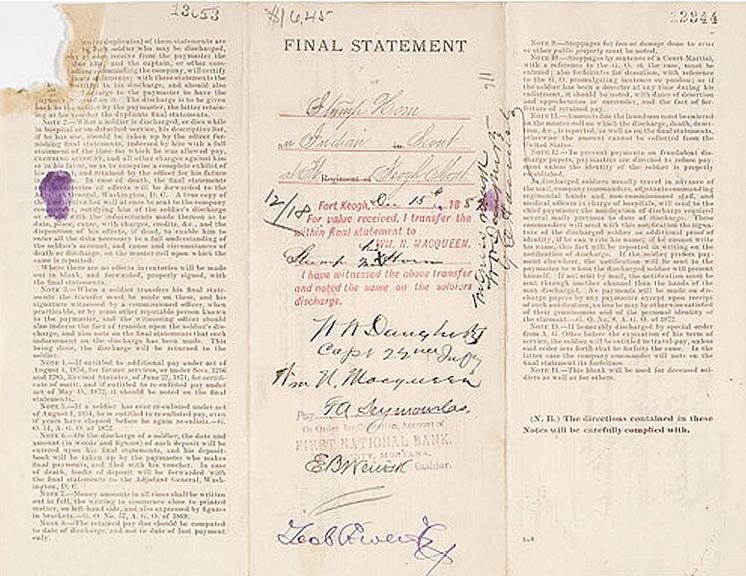
Pay Statement for Stump Horn, Indian
Scout, , December 15, 1889 at Fort Keogh, Montana.
The reverse side of the statement declares that his pay included
$6.10 for retained pay,
$3.25 for clothing not drawn in kind ( uniform allowance ), and,
in a personal remark endorsed by
Lieutenant E.W. Casey of the 22nd Infantry, that Stump Horn was
also entitled to
40 cents per day for "use and risk of horse and horse
equipment".
Signed by Captain W.W. Daugherty, 22nd Infantry.
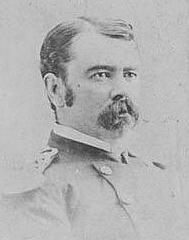
W. W. Daugherty, who signed Stump
Horn's pay statement.
Photo taken in 1879, when he was a Lieutenant in the 22nd
Infantry
Short Biography of William Wirt Daugherty:
Born in Indianapolis , Indiana.
Enlisted as a private in the 27th Indiana
Volunteer Infantry Regiment on 19 April 1861.
Colonel Colgrove's Orderly. Promoted to regimental Sergeant Major
June 1, 1862.
Promoted Second Lieutenant of Company H October 14, 1862.
Promoted regimental Adjutant March 1, 1863.
With regiment in all battles & engagements.
Mustered out November 4, 1864 when term expired.
Recruiting Officer for re-enlistment of regiment's veteran
volunteers.
One of 4 members who served in 3 units within regiment.
Only officer to remain as career United States Army officer.
Served as a 2nd Lieutenant 18th US Infantry 1867
Transferred to 22nd US Infantry December 31, 1870
Regimental Quartermaster 22nd US Infantry October 1, 1881 - September 7, 1882
Promoted to Captain 22nd US Infantry September 7, 1883
Retired February 1, 1893
Died at Indianapolis, Indiana February 4, 1922. Buried at Indianapolis Crown Hill Cemetery
Civil War service data for W.W. Daugherty taken from
The 27th Indiana Volunteer Infantry Regiment
( The above 27th Indiana website was created by
Steve Russell,
who commanded the 1st Battalion 22nd Infantry from 2003-2005 )
During the years 1879 to 1890
the following losses were incurred by the 22nd Infantry.
Places of birth are listed when known.
KIA = Killed In Action
DOW = Died Of Wounds
DOD = Died Of Disease
( A catch-all phrase used in the 19th Century to denote any
non-battle death)
Headquarters
Edward W. Smith.....05/21/1883 - Major - DOD - Vermont - Died of hemorrage of the bowels at Fort Lewis, Colorado
Company A
Charles McCaffrey.....04/30/1879
- Private - DOD - Died of gunshot wound
Enoch Wood.....06/22/1884 - Private - DOD - Manchester, England -
Drowned
William Leukel.....11/24/1884 - Private - DOD - Baden, Germany -
Suicide
Albert G. Hines.....05/13/1887 - Corporal - DOD - Saxony, Germany
- Died of acute hepatitis
Company B
Rudolph Weber.....05/27/1882 - Private - DOD - Austria - Suicide
Company C
Thomas H. Fisher.....07/04/1879
- Captain - DOD - New York - Died of fever at Fort McKavett,
Texas
Patrick Heagerty.....09/15/1888 - Private - DOD - Mayo County,
Ireland - Suicide
Thomas Horton.....10/01/1888 - Private - DOD - Buckinghamshire,
England - Died from injuries after falling under a wagon
Company D
George C. Irie.....08/18/1879 -
Private - DOD - Cleveland, Ohio - Died of typhoid
William H. Hurley.....09/02/1879 - Private - DOD - Kickapoo,
Illinois - Died of typhoid
Oscar D. Ladley.....01/11/1880 - Captain - DOD - Cincinnati, Ohio
- Died of pneumonia
Charles A. Crawford.....09/15/1880 - Private - DOD - Died of
dysentery
Frank Pratt.....09/12/1881 - Private - DOD - Buffalo, New York -
Died of typhoid
John H. Horton.....01/19/1883 - Corporal - DOD - Fort Bridger,
Wyoming Territory - Died of smallpox
Louis Scott.....10/12/1887 - Private - DOD - Canada - Died from
pneumonia
Richard Beale.....12/23/1888 - 1st Sergeant - DOD - Norfolk,
Virginia - Died of dementia
Henry R. Giffin.....06/16/1889 - Private - DOD - Christian
County, Illinois - Drowned
Company E
Anthony Churchill.....06/22/1881
- Private - DOD - Died of remittent fever
Michael J. Holub.....12/14/1881 - Private - DOD - Died of
remittent fever
Gilbert D. Sise.....05/08/1882 - Private - DOD - Ellenville, New
York - Died of remittent fever
Augustine Francis Hewit.....06/03/1882 - 2nd Lieutenant - DOD --
New York, New York - Died of remittent fever
James Hayes.....09/24/1883 - Recruit - DOD - Washington, D.C. -
Died of consumption at Davids Island Recruit Center, never joined
Regiment
Patrick Russell.....02/25/1887 - Private - DOD - Died of
pneumonia
Thomas Donovan..... 12/20/1887 - Sergeant - DOD - Limerick,
Ireland - Died of paralysis of the heart
Thomas Collins.....06/23/1889 - Corporal - DOD - Lowell,
Massachusetts - Drowned
Company F
Reuben Stoller.....07/13/1882 -
Private - DOD - Highland County, Ohio - Died of malaria
Harry Evans.....09/06/1884 - Private - DOD - Otsego, Michigan -
Died of obstructions of the bowels
James M. J. Covey.....04/07/1889 - Private - DOD - Talbot County,
Maryland - Killed by Railroad train
Company G
James Howard.....11/08/1879 -
Private - DOD - Orange County, New York - Died of heart disease -
(Real name was James Brown)
Thomas Cousens.....07/12/1880 - Sergeant - DOD - Brighton,
England - Suicide
Hugh Bates.....05/23/1881 - Private - DOD - Johnston, Scotland -
Died of acute dysentery
Ferdinand Kugler.....10/31/1881 - Private - DOD - Germany - Died
of endocarditis
Alexander Armstrong.....11/19/1883 - Private - DOD - Trenton, New
Jersey - Died of pulmonary hemmorhage
John McCormick.....10/29/1884 - Corporal - DOD - Galway, Ireland
- Died of apoplexy
George Maybrook.....04/27/1886 - Sergeant - DOD - Springfield,
Massachusetts - Suicide
John Burmann.....09/12/1887 - Private - DOD - Germany - Died of
hypertrophy of the head
Joseph Ryan.....07/06/1889 - Private - DOD - Drowned
Company H
Peter Breen.....03/18/1879 -
Private - DOD - Ireland - Died of typhoid
Michael Hyland.....02/02/1882 - Private - DOD - Galway, Ireland -
Died of consumption
Company K
Alpheus Ryan.....07/20/1883 -
Sergeant - DOD - Missouri - Died of abcess of the brain
Edmund F. Anderson.....07/13/1884 - Private - DOD - Drowned
William A. Williams.....09/16/1884 - Private - DOD - Died of
acute acoholism
William O. Yost.....11/24/1884 - Private - DOD - Perry County,
Ohio - Died of malignant toxhaemia
William J. Campbell.....12/17/1886 - 1st Lieutenant - DOD -
Pennsylvania - Cirrhosis of the liver
Band
Isaac F. Horton.....05/16/1882 - Private - DOD - Fort Leavenworth, Kansas - Died of pneumonia
**********************
Much of the above text was taken from the Regimental Histories printed in 1904 and 1922.
Additional material added by the website editor
Additional information taken from:
Returns from Regular Army Infantry
Regiments, June 1821–December 1916. NARA
microfilm publication M665
National Archives and Records Administration, Washington, D.C.
Home | Photos | Battles & History | Current |
Rosters & Reports | Medal of Honor | Killed
in Action |
Personnel Locator | Commanders | Station
List | Campaigns |
Honors | Insignia & Memorabilia | 4-42
Artillery | Taps |
What's New | Editorial | Links |